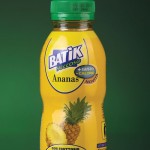What are the Latest Trends Relating to Roll-Fed Shrink Film
The soft drink and sports beverage market is very competitive when designing the proper label to grab the eyes of the consumer. Often we talk about the numerous trends within the labeling industry, and we may have just found a new trend to discuss. Today from Whitlam Group, we will find out how San Benedetto (Italian manufacturer and distributor of soft drinks, sports beverages, and bottled water) solved their problem of finding the right way to label their new contoured juice bottle.
Before 2009, San Benedetto used a polypropylene-based roll-fed shrink label with a hot metal adhesive for its juice brand Batik Succoso. Unfortunately, the polypropylene-based roll-fed film only allowed an eight percent shrink ratio. San Benedetto wanted to upgrade their juice bottle to a contoured bottle to upgrade the look to reflect the high quality of their product.
The polypropylene-based roll-fed shrink label did fit the contoured bottle, but not to the standards of San Benedetto.
“There was a lot of space on the bottle we couldn’t take advantage of, and we felt we were missing an opportunity. Still, we never gave up pursuing film options that would cost-effectively allow us to match the high impact of sleeves,” said a product manager from San Benedetto.
Luckily, San Benedetto’s patience paid off at the beginning of 2009. During this time, they re-launched their new product line of Batik Succoso (pictured below) with a new roll-fed sleeve label identified as polyphane fit STS, which guarantees a shrink ratio of 50 percent.
There are various wonderful features with polyphane fit film; first would be the fact that it is a proprietary polyolefin, which is machine direction oriented. Polyphane fit was developed and manufactured by Polysack Plastic Industries Ltd.
“Polyphane fit films are unique in that they perform more like shrink sleeves than traditional roll-fed shrink. We only had to adjust the graphics slightly to take advantage of the higher shrink ratio and enlarged display area,” said Hubert Mingnolet, sales and marketing manager at Polysack.
Next, San Benedetto wanted to ensure that their new bottle would not have misplaced labels or split seams on the labels, which would portray a mindset of “poor quality” to their consumers. So San Benedetto decided to remove glue from their labeling process to help avoid the above mention problems and increase operating efficiency.
Eliminating glue from San Benedetto’s labeling process was a big money saver in the end. They decided instead of glue they would use a roll fed sleeve technology (RFST) labeler from Sacmi Labeling. The RFST allows an application of wraparound thermo-shrink plastic film labels to start directly from the film on the roll and then use laser-welding technology for the seaming.
According to San Benedetto, their previous roll-fed shrink film required a hot air tunnel that reached nearly 600 degrees to shrink labels at eight percent. Now, with their new process, the company uses a steam generator at 200 degrees.
In the end, their new roll-fed shrink film has reduced their energy consumption substantially and has put San Benedetto in the forefront of the latest roll-fed shrink film trend.
